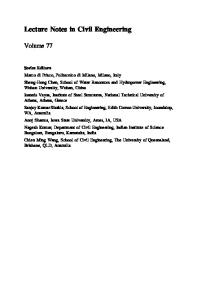Constitutive Modeling of the Stress-Stretch Behavior of Membranes Possessing a Triangulated Network Microstructure
- PDF / 173,961 Bytes
- 6 Pages / 612 x 792 pts (letter) Page_size
- 100 Downloads / 377 Views
L6.8.1
Constitutive Modeling of the Stress-Stretch Behavior of Membranes Possessing a Triangulated Network Microstructure Melis Arslan and Mary C. Boyce Department of Mechanical Engineering, Massachusetts Institute of Technology, 77 Massachusetts Avenue, Cambridge, MA 02139, U.S.A.
ABSTRACT The mechanical behavior of the membrane of the red blood cell is governed by two primary microstructural features: the lipid bilayer and the underlying spectrin network. The lipid bilayer is analogous to a 2D fluid in that it resists changes to its planar area, yet poses little resistance to planar shear. A skeletal network of spectrin molecules is crosslinked to the lipid bilayer and provides the shear stiffness of the membrane. Here, a continuum level constitutive model of the large stretch behavior of the red blood cell membrane that directly incorporates the microstructure of the spectrin network is developed. The resemblance of the spectrin network to a triangulated network is used to identify a representative volume element (RVE) for the model. A strain energy density function in terms of an arbitrary planar deformation field is proposed using the RVE. Differentiation of the strain energy density function provides expressions for the general multiaxial stress-stretch behavior of the material. The stress-strain behavior of the membrane when subjected to uniaxial loading conditions in different directions is given, showing the capabilities of the proposed microstructurally-detailed constitutive modeling approach in capturing the evolving anisotropic nature of the mechanical behavior.
INTRODUCTION Red blood cells experience elastic deformation when they travel through the circulatory system; these deformations can be quite large especially when they enter a capillary. The human red blood cell diameter is approximately 8 m, while the diameter of a capillary is smaller than 3m. The deformation of the red blood cell can be modeled using continuum mechanics. The membrane deformation mechanics are governed by the triangulated spectrin network which provides the shear stiffness and the lipid bilayer which provides the stiffness resisting the changes in the planar area. The mechanical response of the membrane to the applied stretch, i.e. the modulus of the membrane, has been a topic of interest since the early 1950’s. The membrane planar area modulus is very large (500 dyn/cm) compared to the shear modulus (6x10-3 dyn/cm); thus the 2D membrane deforms in a nearly constant surface area manner. Evans and Skalak [1, 2] proposed a 2D incompressible rubber-like model for the membrane, where they found the principal in-plane stresses in terms of Green’s strains and shear modulus. Evans used micropipette aspiration techniques to find the shear modulus of the membrane which is documented as 6x10-3 dyn/cm [3]. Discher [4] formulated the strain energy
L6.8.2
function for a representative volume element (RVE) of the triangulated network and utilized this model to study a limited set of specific stress-strain behaviors as well as to ass
Data Loading...










